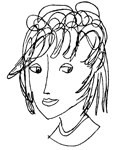How far can you press a poet?
To the last limit and he’ll not show it
And one step further and he’s dead
And his death is upon your head.
Which brings us to Stevie Smith, the cartoon-drawing, school-girl dress-wearing, near doggerel-spouting British poet who died in 1971 at age sixty-nine. It’s probably fair to say that of all poets generally considered to be “serious,” Stevie Smith ranks among the silliest, both personally and poetically. As to the former, this was largely a matter of presentation—in addition to her eccentric wardrobe, Smith was known for warbling her poems during readings in a manner that Seamus Heaney once characterized as a cross between “an embarrassed party-piece by a child… and a deliberate faux-naif rendition by a virtuoso.” As for the poetry itself, well, Stevie Smith is a willfully ridiculous writer—or, as some have preferred, “eccentric” (Heaney), “completely original” (Philip Larkin), and “a rare bird” (Clive James)—which means, more or less, that nobody has a clue as to how to describe her. You could talk about the peculiar rhythm of lines like, “All the waters of the river Deben/ Go over my head to the last wave even.” You could mention the clowning, idiosyncratic rhyming (“Under wrong trees/ Walked the zombies”), which makes many of her poems sound like badly translated ballads. You might pause over the patently ludicrous asides (“May we inquire the name of the Person from Porlock?/ Why, Porson, didn’t you know?”) with which she interrupts poems that examine creative exhaustion and the longing for death. You could dwell on her bizarre habit of including throwaway jottings, not to mention amateurish cartoons, beside her most accomplished pieces. You could discuss her obsessive morbidity (“I cannot help but like Oblivion better”), her piercing humor (“This Englishwoman is so refined/ She has no bosom and no behind”), or her fearful tenderness (“I can call up old ghosts, and they will come,/ But my art limps,—I cannot send them home”). You could do all of this and more. But something would still be missing.
In fact, the best description of a Stevie Smith poem is not a description of a Stevie Smith poem at all, but rather an account of one of her public readings by the art historian Norman Bryson that appears in Frances Spalding’s enjoyable Stevie Smith: A Biography. Here’s what Bryson witnessed:
The performance was unnerving because it was so excessive… The meaning of the words was set aside in the performance. And the motives for this were entirely unrevealed: this seemed almost the main point. It was as though what was being dramatized was a state of being so pent up, so...
You have reached your article limit
Sign up for a digital subscription and continue reading all new issues, plus our entire archives, for just $1.50/month.
Already a subscriber? Sign in





